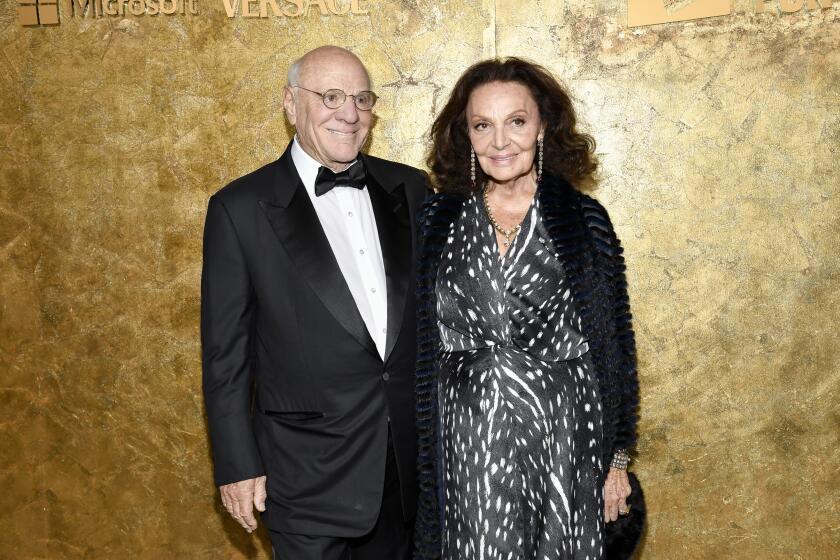MUSIC REVIEW : Salonen, Sellars Try to Fit Under Same Umbrella
- Share via
The so-called Green Umbrella programs (ask not why they’re called that) don’t usually find the Los Angeles Philharmonic courting the masses.
Dedicated to the exploration and preservation of modern music in an intimate ghetto, the concerts in question tend to be esoteric affairs--sometimes dutiful, sometimes mystifying, sometimes actually exciting. They normally take place in the Japan America Theatre, which seats 841. No one is shocked when half the seats are empty.
It wasn’t anything like that on Monday night.
Esa-Pekka Salonen was in charge, sporting the de rigueur black tux with red tie. For this festive occasion, he moved the umbrella to the wide-open spaces of the Dorothy Chandler Pavilion. Although the two top balconies were closed, a large, youthful, happy crowd nearly filled the orchestra and mezzanine levels. There was a lot of whoopin’ and hollerin’.
Small wonder.
Salonen comes just about as close as a conductor can these days to matinee-idol status, and he was just one of the obvious attractions here. Peter Sellars, the bad-boy staging wizard who lately has seemed more bad than boyish, was billed as director. Janice Felty, rapidly turning into a secret underground diva, was promised as soloist. And the accessible repertory included folk music arranged by Luciano Berio, some rowdy duty courtesy of John Adams and a golden oldie from Arnold Schoenberg.
The worst came first. Berio’s Folk Songs, 11 traditional settings spanning America and Azerbaijan, with other excursions in between, celebrate eternal innocence. Half piquant, half poignant, they require a virtuosic singer who has a way with words (Cathy Berberian was, of course, the first, back in 1966), assisted by a virtuosic, unorthodox chamber ensemble. The songs do not require visual crutches, but Sellars has always been a man who likes to rush in where fools fear to tread.
*
Bravely, he turned Berio’s music into a moving-picture show. Make that a jerking-picture show.
Clad in earthy tank top and jeans, Felty sang with affecting but unaffected sweetness, with purity and bravado, as needed. She also struck self-conscious poses, dropped to her knees, did a little crawling and stretched out on the forestage, none of which was needed. Salonen and his little band provided sensitive, invigorating, carefully nuanced accompaniment.
Unfortunately, Sellars wouldn’t let us pay much attention. He demoted the wonderful score to background music for an artsy-amateurish film. Irrelevant, potentially erotic close-ups of innocent body parts (hair, hands, limbs, fingers, eyes) gave way to minute examinations of cheap religious artifacts and fast-frame figures romping al fresco. The visual images--no doubt fraught with profound significance for the initiated--added little and detracted a lot.
Oh, well. . .
According to Adams, his Chamber Symphony of 1992 was inspired by Schoenberg’s Chamber Symphony of 1906. At the same time, it owes a great deal to the loony tunes and merry melodies propelled in the silly symphonies of the modern cartoon. We should be grateful, I suppose, that Sellars resisted illustrating the performance on Monday with the cinematic facsimiles of that smart-alecky bunny or that ever wily, ever frustrated coyote.
Here, thank goodness, the music was the thing. With Salonen beating time carefully and con brio , it was a very splashy, very agitated thing.
Adams’ honky-tonky exercise in perpetual motion is never less than amusing (even without a beep-beep in the “Roadrunner” section). It even offers some serious stimulation for those willing to listen beyond the jokes.
Jorja Fleezanis of the Minnesota Orchestra, serving a two-week stint as guest-concertmaster, turned the convoluted cadenza of the finale into a staggering, deceptively easy tour de force. It would be interesting to hear more of her.
After intermission, Salonen paid discerning attention to the crumbling Romanticism of Schoenberg’s model Chamber Symphony. In context, it sounded like Richard Strauss without the padding.
*
Incidental intelligence:
* A strange cranking noise added an unexpected obbligato to the Berio songs. Carmine Marinelli, the masterly master of properties, attributed the sounds to misbehaving elevator motors called into action because Salonen chose to play on an extended thrust stage.
* Adams’ Chamber Symphony had to be delayed a few moments because Evan N. Wilson, the violist, forgot to bring his score onstage. Then the opening section had to be interrupted when a string broke on Wilson’s viola. When the problem was corrected, Salonen decided to start again from the top.
* After performing Adams’ Chamber Symphony, Salonen and the composer played a neat game of he-went-that-a-way-which-a-way. The maestro kept beckoning east, thinking Adams would make his entrance from that side of the house to take a bow; meanwhile Adams was blithely making his way center-stage from the west.
* The Philharmonic management swore on a stack of “Sacres du Printemps” that none of these engaging contretemps had been staged by Peter Sellars.
More to Read
The biggest entertainment stories
Get our big stories about Hollywood, film, television, music, arts, culture and more right in your inbox as soon as they publish.
You may occasionally receive promotional content from the Los Angeles Times.










